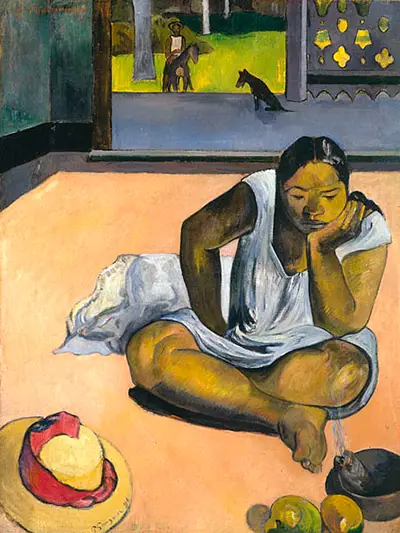The painting features a silent and meditative subject, which is the woman. The woman appears to be sitting on the floor with one of her hands on her chin and one side of her face, and the other hand on her waist or upper thigh. Her legs are crossed like in some yoga pose that isn't intentional or meant to exercise. Her shite dress appears to be flowing on one side behind her. This indicates that she is wearing a long dress, and the flowing part would have covered her legs if she was standing. Her legs are exposed from the lower part of her knee to the foot for one leg and the ankle's upper part for the other. The woman's thick physique is that of a typical Polynesian woman.
On the top part of the painting, behind the woman are two animals and another woman wearing a cowboy hat. She appears to be sitting on one of the animal's backs. There are a door and decorated wall in the same area. The term brooding woman is a testament to the facial expression of the woman. She appears to be brooding while staring at some utensils in front of her. Paul Gauguin uses a wide range of colors. Paul used different dark and colorful colors in this painting, as in most of his works in Tahiti. His use of color is so unique that despite many copies of the Brooding Woman by other artists, none seems to come close to the original piece.
Paul Gauguin considered this painting to be the best of his works from the time he stayed in Tahiti. He painted this piece during the first two days of his time in Tahiti. He found the Polynesians to be a very mysterious person during his early days in this country. Therefore, Paul Gauguin used the painting to convey his feelings and sense of mystery that the Polynesians evoke. The Brooding Woman painting currently sits at the Worcester Art Museum in Worcester, Massachusetts, USA. The same museum hosts several other art pieces by Paul Gauguin. The piece is available for the public to view.

